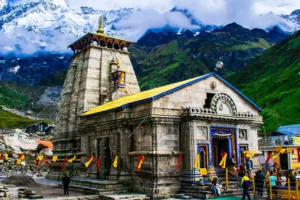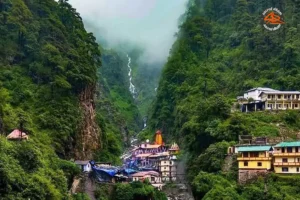Gangotri Temple
The Gangotri Temple, dedicated to Goddess Ganga, was built in the 18th century by Gorkha General Amar Singh Thapa. It stands on the left bank of the Bhagirathi River, surrounded by serene deodar and pine forests. Nearby lies the sacred Bhagirath Shila, the spot where King Bhagirath is said to have worshipped Lord Shiva.
The priests and pujari families serving at the temple come from the village of Mukhwa. Devotees carry water from Gangotri to offer Lord Shiva, as it is believed this divine water holds nectar that soothes his throat after consuming poison.
What to Know About Gangotri
Gangotri, one of the Char Dhams, along with Yamunotri, Kedarnath, and badrinath – the most sacred pilgrimage circuit in northern India—is a small town in Uttarkashi with the temple of Goddess Ganga at its core. Located about a 12-hour drive from Rishikesh, Gangotri sits amidst the majestic Garhwal Himalayas, glaciers, and dense forests, making it one of the highest pilgrimages in India at nearly 3,415 metres.
Beyond its spiritual aura, Gangotri offers breathtaking Himalayan views in every direction. According to Hindu mythology, this is the place where the holy Ganga descended from heaven, released from Lord Shiva’s locks. The river’s true source lies at Gaumukh in the Gangotri Glacier, about 19 km away, which can be reached by trekking. From Gaumukh, the river flows as Bhagirathi and is later called the Ganga after merging with the Alaknanda at Devaprayag. The temple kapat is now open for darshan.
Gangotri Dham becomes a bustling hub of devotees during the Char Dham Yatra season (May to October).
Attractions Near Gangotri Temple
Kedartal
Kedartal, often called the lake of Lord Shiva, is a breathtaking emerald glacial lake surrounded by towering snow-clad peaks. The trek to this destination covers nearly 18 km from Gangotri and is considered challenging, but the reward is unforgettable—the crystal-clear waters mirroring the majestic Thalaysagar peak.
At an altitude of about 4,912 metres, Kedartal is among the highest glacial lakes in Uttarakhand. Standing by its serene shores offers a panoramic view of some of the most magnificent Himalayan summits, including Manda, Bhrigupanth, Meru, and Thalaysagar.
Tapovan
Tapovan is a breathtaking meadow at an altitude of about 4,463 metres, nearly 25 km from Gangotri. It serves as the base camp for mountaineers heading to peaks like Shivling and Bhagirathi. Counted among the most beautiful high-altitude meadows, Tapovan also lies close to Nandanvan, another stunning meadow at the foot of the Bhagirathi massif.
Bhairon Ghati
Around 10 km from Gangotri lies Bhairon Ghati, a valley set near the confluence of the Jat Ganga and Bhagirathi rivers. Thick forests surround this spot, and the revered temple of Bhairav Nath adds to its spiritual charm.
Gaumukh
Gaumukh, the glacier that gives birth to the Ganga, is a sacred site where the river gushes out of a snout-shaped opening and flows as the Bhagirathi. The trek from Gangotri to Gaumukh takes nearly 10 hours and offers a moderately challenging but rewarding journey.
Underwater Shivling
Close to the Gangotri temple rests a natural rock Shivling submerged in water. During winter, when the water level drops, the Shivling becomes clearly visible. Devotees believe this is the spot where Lord Shiva received the mighty Ganga in his locks before releasing her flow onto earth. Mythology narrates how Goddess Ganga descended to purify the ashes of King Bhagirath’s ancestors after his deep penance. To prevent destruction from her powerful descent, Lord Shiva gently caught her in his matted hair before letting the river flow.
Pandava Gufa
About 1.5 km from Gangotri temple, Pandava Gufa is a cave steeped in legend. The Pandava brothers from the Mahabharata are said to have spent time here during their exile. A serene two-hour forest walk leads to this cave, now inhabited by a sage. Many devotees visit, especially since it is believed that Baba Ramdev once practiced here in his early years.
Gangotri Temple
The pristine white Gangotri temple rises gracefully against the backdrop of the mighty Himalayas on the banks of the Bhagirathi. Inside the clean temple complex stands a beautiful idol of Goddess Ganga, while smaller shrines surround it. Pilgrims often take a ritual dip in the Bhagirathi before offering prayers. As part of the Char Dham Yatra, Gangotri Dham holds the second stop, after Yamunotri.
Gauri Kund and Surya Kund
Just 500 metres beyond the Gangotri temple lies Surya Kund, a powerful waterfall on the Bhagirathi where devotees worship the Sun God. An iron bridge links it to another sacred cascade, Gauri Kund. Both spots not only hold spiritual importance but also provide incredible photo opportunities.
What To Do
You can reach Gangotri easily by motorable roads, but to visit Gaumukh—the glacial source of the River Ganga—you need to trek about 19 km through Gangotri National Park. Adventure seekers can also explore several other trekking routes in the region, leading to Tapovan, Nandanvan, and Kedartal.
Weather of Gangotri
Winter (November to April)
Winters in Gangotri are extremely harsh, with freezing temperatures and heavy snowfall. During this season, the Gangotri temple remains closed. Only experienced trekkers and mountaineers venture into the region for high-altitude expeditions.
Summer (May to June)
Summers bring cool and pleasant weather, making it the best time for pilgrimages and sightseeing. The temple gates open with the arrival of summer, and daytime temperatures hover around 25°C. Nights, however, can still get quite cold.
Monsoon (July to mid-September)
Monsoons create challenging conditions in Gangotri due to frequent landslides and heavy rains. Traveling during this period is not recommended for pilgrims.
Best Time to Visit
The ideal time to visit Gangotri is between April and June, and again from September to November. The temple generally opens in the last week of April and closes by the second week of November.
How to Reach
By Flight:
Jolly Grant Airport near Rishikesh is the closest air link to Gangotri, situated just 26 km away. After landing, travelers can either book a taxi or choose a luxury bus to continue their journey toward Gangotri.
By Train:
The nearest railway station lies in Rishikesh, around 249 km from Gangotri. From here, travelers can hire a cab or board a luxury bus for the remaining distance. Since Rishikesh lacks fast train services and Kotdwar has limited connectivity, Haridwar stands out as the most convenient railhead. Haridwar connects well with major cities across India, offering better travel flexibility.
By Road:
Reaching Gangotri by road is convenient, thanks to its well-maintained connections with major cities across Uttarakhand, Uttar Pradesh, Delhi, and the NCR. The distance from Delhi to Gangotri is approximately 452 km, while Rishikesh is about 229 km away, making it a comfortable road trip option.
Accommodation
Following options of accommodation are available at Gangotri & nearby places.
At Gangotri
Accommodation choices in Gangotri are limited and mostly consist of private hotels. Travelers should plan accordingly, especially during peak pilgrimage seasons.
Accommodation at Nearby Places
Pilgrims can opt to stay in Uttarkashi, located around 20 km from Gangotri. From here, it’s easy to complete the Gangotri darshan in a single-day trip. Uttarkashi offers a decent selection of hotels with reasonable amenities.
Conclusion
If you are longing for peace of mind and a soulful retreat, Gangotri Temple is the perfect place to visit. Step into the sacred temple complex and fulfill your spiritual journey with divine blessings. Let the atmosphere of Gangotri surround you with serenity and devotion, offering an experience unlike any other.





